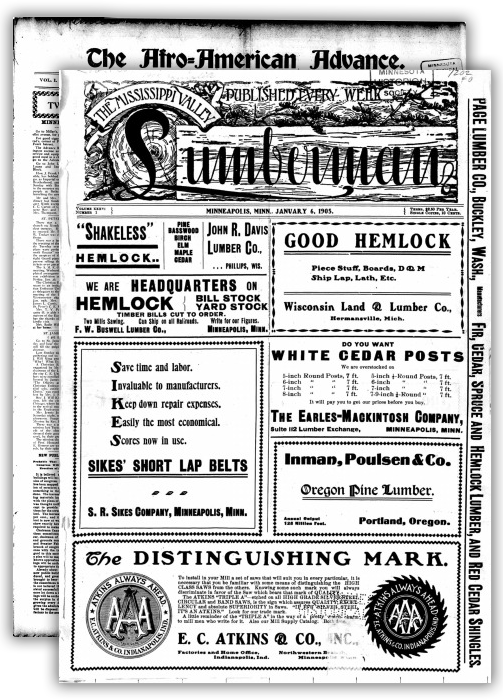
hub
Introduction
titles
About the titles
corporations foundations
Search the Newspapers
hub-faq
F.A.Q.
Choose a Menu
-
hubIntroduction
-
titlesAbout the titles
-
corporations foundationsSearch the Newspapers
-
hub-faqF.A.Q.
Felt Raabet
Felt raabet (Minneapolis, Minn.) 1887-1889 Browse the title
Felt Raabet (“Battle Cry”) was a Norwegian-language weekly news and temperance newspaper published in Minneapolis, Minnesota from 1887 to 1889. It began publication on May 13, 1887, as a four-page, six-column newspaper that covered local, regional, national, and international news. The editor and later co-owner of Felt Raabet was Hallvard Tobias Askeland, who emigrated from Stavanger, Norway to Minneapolis in 1875. Askeland graduated from Augsburg Seminary in Minneapolis in 1882, taught music for a several years, and then became editor of the Felt Raabet. He was also for a time organist of the Norwegian Lutheran Trinity Church and secretary of the Minnesota Total Abstinence Association.
Proclaimed as “A Norsk Prohibitions-Blad” (or “A Norwegian Prohibition-Paper”) on its masthead, Felt Raabet appealed to the large segment of the Norwegian American community that opposed alcohol consumption. Some English-speaking Norwegian Americans made fun of the paper’s name, calling it “The Felt Rabbit.” Nevertheless, it attained a large circulation, reaching 4,000 subscribers by 1888, not least because the owners had many friends who subscribed.
The Felt Raabet offices were located at 408 and 410 Cedar Avenue, Minneapolis, in the heart of a large Scandinavian district. In the late 1800s, and through the turn-of-the-century, the area around Cedar Avenue was the commercial hub of the Minneapolis Scandinavian immigrant community. The new residents lived in boarding houses in the neighborhood, where Swedish, Norwegian, and Danish languages were spoken in many businesses. The community was close to the city’s industrial area so it was easy for new immigrants to walk to their jobs at the mills. The neighborhood was also well known for its many dance halls, saloons, theaters and meeting halls.
For those Scandinavians strongly opposed to liquor and who advocated for temperance there were other influences in the neighborhood, such as the Swedish-founded I.O.G.T. (Independent Order of Good Templars) Hall which provided social and cultural activities without alcohol, and the Salvation Army’s Scandinavian Corps which held temperance rallies. So Cedar Avenue was not a surprising spot for a Norwegian language prohibition paper to be headquartered.
According to Carl G.O. Hansen’s book My Minneapolis, Norwegian author “Knut Hamsun and a number of other ‘intellectuals’ found the Feltraabet office a pleasant place to while away the hours, and in a modest way it became quite a cultural center.” Hamsun, the 1920 Nobel Prize winner in literature, also contributed editorials and sent letters to Felt Raabet when he was traveling in Europe.
Felt Raabet ceased publication around November, 1889. According to an article on December 4, 1889, in the North, an English language newspaper for Scandinavian Americans, plans were being made in late 1889 to merge Felt Raabet with the newspaper Reform of Eau Claire, Wisconsin to form a new paper to be named Fremad (“Forward”) and edited by Askeland. This does not appear to have come to pass because when the Felt Raabet ceased Askeland became a librarian at a local branch of the Minneapolis Public Library.
Minnesota Digital Newspaper Hub
The Minnesota Digital Newspaper Hub is a searchable website from the Minnesota Historical Society that makes millions of pages of Minnesota newspapers available online.
The Hub contains geographically and culturally diverse newspapers published between 1849 and today. Due to potential copyright restrictions most issues published after 1977 can only be accessed from the Gale Family Library at the Minnesota History Center.
The Minnesota Digital Newspaper Hub incorporates Minneapolis Tribune titles previously found on a stand-alone website, foreign-language titles, and much more, with new titles and date ranges continuously being added.
The Minnesota Historical Society's newspaper digitization program is made possible through support from the National Endowment for the Humanities and the National Digital Newspaper Program (NDNP), the Legacy Amendment's Arts and Cultural Heritage Fund through the vote of Minnesotans on Nov. 4, 2008, SELCO (Southeastern Libraries Cooperating) through a grant from the Minnesota Arts and Cultural Heritage Fund for Libraries, and many other organizations and individual donors.
Material in the Digital Newspaper Hub may be protected by copyright law (U.S. Code Title 17).
Looking for more information on MNHS digital newspaper collections? Visit Digital Newspapers at MNHS
